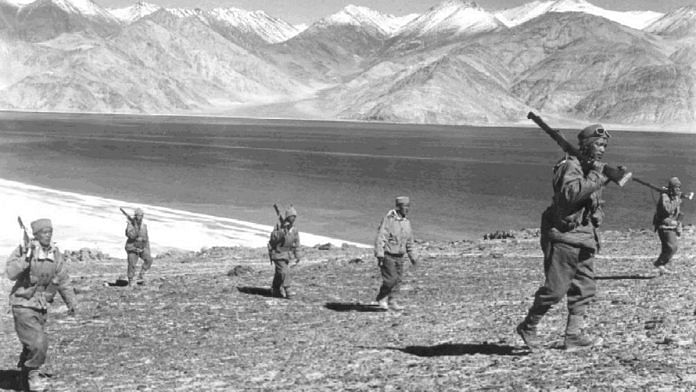New Delhi: Why did India face a war for which it wasn’t prepared in 1962? Experts, political commentators and former military personnel have attributed the outcome of the war to a host of reasons over the past 60 years.
These range from flawed military plans, command and control issues, and intelligence gaps, to the Indian political leadership’s miscalculation that Beijing wouldn’t launch an armed response to Delhi’s ‘Forward Policy’, which involved installing military outposts in areas claimed by the Chinese.
Often described as a “humiliating defeat” for India, the war in 1962 saw 10,000 to 20,000 Indian soldiers go up against roughly 80,000 Chinese troops.
Political commentator and strategic analyst Wasbir Hussain, in a 2014 piece for New Delhi-based think tank Institute of Peace and Conflict Studies (IPCS), argues that India’s unpreparedness in 1962 was underlined by the manner in which Chinese forces entered Indian territory, seized Aksai Chin and almost reached “the plains of Assam”.
“The People’s Liberation Army (PLA) came in on two separate flanks — in the west in Ladakh, and in the east across the McMahon Line in the then North-East Frontier Agency (Arunachal Pradesh). China had successfully occupied Aksai Chin — a strategic corridor linking Tibet to western China — the NEFA area, and had almost reached the plains of Assam,” he wrote.
Further, military experts have pointed out that in certain battles with the Chinese, such as the Battle of Rezang La, Indian soldiers were at a disadvantage on account of three factors: the high crests of the mountain tops deprived Indian troops of artillery support, they weren’t acclimatised to the harsh winter conditions, and they had inferior military equipment such as .303 bolt-action rifles dating back to World War II.
India drew many lessons from the conflict, and even acknowledged strategic mistakes such as not deploying the Indian Air Force (IAF).
Also Read: Zhou’s offer, Nehru’s defiance — insights from 3-week ‘lull period’ during 1962 India-China war
Command & control issues
To decode the Indian military’s unpreparedness for the war, scholar Srinath Raghavan, in his book War and Peace in Modern India, briefly looks at the transition the Indian Army underwent a decade prior to the conflict.
“In retrospect it is clear that this transition was not unproblematic. Not because Indian officers were in any way less capable than their British counterparts, but because several of them had less than adequate preparation for higher command particularly at the strategic level,” Raghavan argues.
Experts such as Seshadri Chari have written of other structural issues such as the setting up of the Defence Production Planning Committee in 1957 and the Department of Research and Development under the Ministry of Defence in 1958, which according to Chari were “utterly sloppy and non-functional”.
Such bodies deprived the armed forces of basic military hardware and ammunition, he contends.
Chari adds that three years before war broke out, the Army had unresolved issues with the political leadership in New Delhi, which he describes as “absence of political-military synchronisation”.
The resignation of the then Army chief, General K.S. Thimayya, was a prime example. In September 1959, Thimayya submitted his resignation letter to Prime Minister Jawaharlal Nehru following a disagreement with the defence minister, V.K. Krishna Menon, but later withdrew it.
Malcolm MacDonald, then British high commissioner to India and Thimayya’s neighbour, submitted a report on the incident to the British government, based on his “long conversations” with Thimayya.
Reportedly, MacDonald said Thimayya told him that Menon “was perhaps trying deliberately to make himself the master of the armed forces so that he might one day have their support in the achievement of his political ambition to take Mr Nehru’s place either after, or even before, Mr Nehru’s withdrawal from public life”.
The Thimayya incident aside, experts have also written about Menon’s attitude while interacting with Chinese officials in the months before the war.
For example, international affairs expert John W. Garver wrote of how on 23 July 1962, during a conference in Geneva, Chinese foreign minister and PLA marshal Chen Yi was told to seek out Menon, and urge him to find ways of preventing the border situation from further deteriorating.
Chinese accounts of the interaction claim Menon was “arrogant” and turned down the prospect of a joint India-China communiqué announcing future talks on the border conflict.
It was after this interaction that Chinese Premier Zhou Enlai concluded that Menon “showed no sincerity regarding peaceful talks” and that Nehru wanted “a war” with the Chinese, writes Garver.
Problems with Nehru’s Forward Policy
Experts have argued that Nehru’s ‘Forward Policy’ exacerbated India’s unpreparedness in the war.
The policy, which was in effect from November 1961 to October 1962 and involved frontier patrolling on disputed areas, is believed to have been driven by Nehru’s firm belief that the Chinese would not respond with armed retaliation. Garver calls this assertion on Nehru’s part an “egregious” miscalculation.
This policy was put in place despite the consideration that India, compared to China, was at a disadvantage when it came to troop capacity, soldiers’ acclimatisation to terrain and other infrastructural factors.
According to Pakistani veteran Major (Retd) Qasim Hameedy, officers of the PLA, from squad to division level, were acclimated to the terrain in Tibet. “Three divisions of the PLA 18th Corps had moved to Tibet as early as 1950,” he writes in a 2013 research paper presented to the US Army Command and General Staff College (CGSC).
Further, the classified 1963 Henderson Brooks-Bhagat report — parts of which were released by Australian journalist Neville Maxwell in 2021 — says Indian troops had little space to manoeuvre on the battlefield compared to their Chinese counterparts.
“Our roads, even when fully developed, will not have the capacity to sustain major operations… Accessibility to Daulat Beg Oldi and Hot Spring Sectors in the Karakoram Mountains will always be difficult,” notes the report.
(Edited by Amrtansh Arora)
Also Read: Bayonets, Gorkha Khukris & hands: How Indian soldiers tried to defend Chushul during 1962 war



